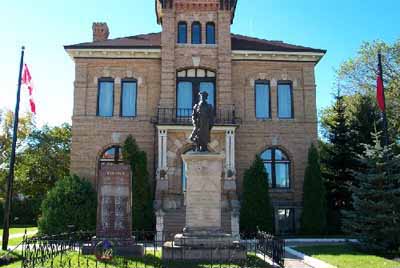Neepawa Court House / Beautiful Plains County Court Building National Historic Site of Canada
Neepawa, Manitoba

General view
(© Parks Canada Agency / Agence Parcs Canada, 2001.)
Address :
282 Hamilton Street, Neepawa, Manitoba
Recognition Statute:
Historic Sites and Monuments Act (R.S.C., 1985, c. H-4)
Designation Date:
1980-01-16
Dates:
-
1884 to 1884
(Construction)
Event, Person, Organization:
-
Manitoba Ministry of Justice in Beautiful Plains County
(Organization)
-
Rural Municipality of Rosedale
(Organization)
-
Charles Osborn Wickenden
(Architect)
Other Name(s):
-
Neepawa Court House / Beautiful Plains County Court Building
(Designation Name)
-
Rural Municipality of Rosedale Offices
(Other Name)
Research Report Number:
TOWN HALLS OF CANADA 1978-81, CDN. COURT HOUSE
Plaque(s)
Existing plaque: Just west of Court House 282 Hamilton Street, Neepawa, Manitoba
The need for public buildings such as court houses and town halls accompanied the settlement of Western Canada. A town's future as the administrative centre for a newly settled region could be ensured by the construction of such facilities. At Neepawa, accomodations for the county court, town hall, jail and theatre were combined to justify construction of this substantial building in 1884, a very early date for such an undertaking on the prairies. It became an enduring landmark, affirming its builders' faith in the future of their community and the West.
Description of Historic Place
A stone’s throw from the commercial heart of the town of Neepawa, Neepawa Court House / Beautiful Plains County Court Building National Historic Site of Canada is an imposing two-storey buff brick building, located on an open site. Constructed in 1884, when the surrounding district was in its earliest stage of settlement, the structure served as county and municipal offices, a circuit judges’ courthouse, police station and theatre, thereby securing Neepawa’s role as the most prominent town in the district. The building now houses offices of the Municipality of Rosedale. The designation refers to the building on its lot.
Heritage Value
The Neepawa Court House / Beautiful Plains County Court Building was designated a national historic site of Canada in 1980 because: used as the county court, jail, municipal offices and a theatre, this substantial building is representative of a significant functional type.
Having secured the railway line to the village in 1882, Neepawa was thereafter named the seat of the County of Beautiful Plains, which encompassed four municipalities. The county system, discontinued as too unwieldy after 1890, continued to lend its name to the new provincial building, although the town actually straddled the newly created Rural Municipalities of Langford and Rosedale. In 1884, the government of Manitoba agreed to share the cost of construction of the new civic structure if space could be provided for the circuit judges’ court, thus making the town both the district judicial and civic centre. Town leaders in Neepawa wasted no time in securing an architect and commencing construction. Completed in 1884, the new brick courthouse and civic office remained the town’s only brick structure for the next five years, serving as county court, town hall, jail, and theatre
The design was awarded to one of the young province’s foremost architects, British-trained C. Osborn Wickenden, who contributed several prominent public buildings to Manitoba and later to British Columbia. A Portage la Prairie construction firm had the expertise to provide the skillful handling of the decorative brickwork of the courthouse. The high-quality bricks were also manufactured in Portage, which speaks to the sophistication of artisan skills developing on the Prairies. In 1982, strong local support for the preservation of the Neepawa Court House / Beautiful Plains County Court and municipal offices as part of the town’s centennial anniversary celebration demonstrated how significant a landmark it remains within the district.
Sources: Historic Sites and Monuments Board of Canada, Minutes, March 1980; Plaque text, 1985.
Character-Defining Elements
Key elements that express the heritage value of the Neepawa Court House / Beautiful Plains County Court Building include: its visual prominence in the downtown area; its setting within a landscaped property containing two war memorials; its rectangular massing with a prominent frontispiece with tower, and rear pavilion; its local buff brick exterior walls with limestone trim on a raised foundation of granite and gneiss boulders; the quality of craftsmanship of its solid brick construction, with decorative belt courses and corbelling, and recessed panels setting off the upper windows; its elements of the Queen Anne Revival style, blending classical elements such as the pedimented tower, the symmetrical façade and the heavy stone detailing of the front entrance and stairway; its original public space on the second floor, featuring a partially-coffered ceiling with carved wooden hammer-posts and tie-beams; all the original window openings, in particular the large round-headed ones on the east elevation; its continuous use as a multi-purpose facility serving the public of Neepawa and district.